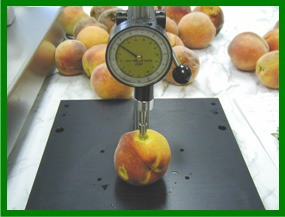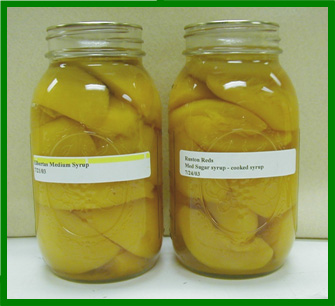
Sugar substitutes are important in controlling calorie intake for consumers with health problems including obesity and diabetes. Among these, Splenda® (sucralose) is popular and suitable for inclusion in heat processed products. Consumer driven demands for safe, acceptable, shelf-stable home-canned fruit containing sugar substitute, necessitated a research based recommendation for home canned peaches containing Splenda®.
The objective was to recommend a process for peaches canned in Splenda® sugar substitute, based on product development and analysis of consumer sensory preferences.
Selected ‘Ruston Red’ peaches were canned in water, medium sugar syrup, full-strength ‘medium’ Splenda® syrup and half-strength ‘medium’ Splenda® syrup, using the USDA boiling water process for peaches. Physicochemical characteristics of fresh, canned and pre-consumption peaches were recorded, including pH, firmness, titratable acidity, percent soluble solids, and color. Peaches were stored in a temperature-monitored environment for 15 months and a consumer preference study followed. 42 respondents indicated their preferences for each sample using a 9-point hedonic scale and took a short survey providing information about their food preparation and consumption practices. Attributes scored included appearance, color, aroma, flavor, texture, sweetness, tartness, aftertaste and overall acceptability.
Overall acceptability was highest for peaches canned in sugar syrup, followed by full strength Splenda®, half strength Splenda®, and lastly, water. Full-strength Splenda® rated higher than half strength Splenda® on appearance, color, aroma, flavor, and texture while the half strength product scored higher on tartness and sweetness. There was no difference in aftertaste detection between the two. One-third respondents would be willing to buy either Splenda® product. The products were acid, hence suitable for boiling water canning.
A safe process for home-canning peaches using a sugar substitute is both timely and necessary. This study provides a research- and consumer-endorsed home-canning recommendation for peaches canned with medium strength Splenda® syrup that is both safe and acceptable.
Home-canning of home-grown or locally purchased produce is a popular practice in the U.S (Andress, 2001). Abundant availability of summer fruits, especially peaches, prompts consumers to preserve these through canning. However, increasingly, a demand (fueled by health concerns about obesity and diabetes) has arisen for alternatives to sugar used in home-canned foods. The objective of this project was to develop a high-quality home-canned peach product using a non-nutritive sweetener, and to carry out a consumer preference study to determine the ideal level of sweetener to be added. Storage monitoring of the product determined the shelf-life that would be recommended for this product.
Canning Methods: The USDA recommended Boiling Water process for home canning peaches was followed (USDA, 1994). ‘Ruston Red’ Elberta-type peaches ideal for cooking were obtained from a local peach orchard (Washington Farms, Watkinsville, GA). The peaches were sorted for quality and ripeness. Care was taken to maintain equivalency in peach ripeness stage (assessed by tactile firmness).

A Consumer Sensory Preference study was conducted with 42 respondents including University students, staff and faculty. A 9-point Hedonic scale was used for the respondents to score several attributes (see Table 1) for each of the 4 canned peach products mentioned above.
Respondents also answered a questionnaire that covered their fruit consumption and buying practices; home-canning experience; use of sugar substitutes, and demographic questions.
Figure 1: Overall Sensory Acceptability Scores of Panelists for Four Canned Peach Products

Significant Characteristics of Sensory Preferences
 ‘Full-strength’ Splenda®
‘Full-strength’ Splenda®  ‘Half-strength’ Splenda®
‘Half-strength’ Splenda®  Water.
Water.
How often do they consume fruit (n=42)?
|
Do they or family members home can foods?
Do they regularly use sugar substitutes?
Why do they use sugar substitutes?
|
| 1. | Andress, E.L. 2001. A national survey of current home canning practices in the U.S. Athens, GA: National Center for Home Food Preservation, Department of Foods and Nutrition, The University of Georgia. Unpublished data. | |
| 2. | Andress, E.L. and J. A. Harrison. 2006. So Easy To Preserve, 5th Ed. Cooperative Extension Service Bulletin 989, The University of Georgia, Athens, GA.. Canning Fruits – Canning Peaches, p.42. | |
| 3. | Statistical Analysis Software, SAS 9.1, 2002-2003. Cary, NC: SAS Institute Inc. | |
| 4. | USDA. 1994. Complete Guide to Home Canning. USDA Extension Service. Agriculture Information Bulletin No. 539. Canning peaches, p.16. |

This project was partially funded through a grant from the National Integrated food Safety Initiative (Grant No. 00-51110-9762) of the Cooperative State Research, Education, and Extension Service, U.S. Department of Agriculture.
The authors acknowledge Dr. Ruthann Swanson, Department of Foods & Nutrition, University of Georgia, for her assistance with the experimental design of the Sensory Preference study.
Document Use:
Permission is granted to reproduce these materials in whole or in part for educational purposes only (not for profit beyond the cost of reproduction) provided the authors and the University of Georgia receive acknowledgment and this notice is included:
Reprinted with permission of the University of Georgia. E. M. D'sa and E. L. Andress. 2006. Developing a Recommendation for Home-Canned Peaches with a Sucralose Sugar Substitute. Athens, GA: The University of Georgia, Cooperative Extension Service.
References to commercials products, services, and information is made with the understanding that no discrimination is intended and no endorsement by the University of Georgia, U.S. Department of Agriculture and supporting organizations is implied. This information is provided for the educational information and convenience of the reader.
The University of Georgia and Ft. Valley State University, the U.S. Department of Agriculture and counties of the state cooperating. The Cooperative Extension Service, the University of Georgia College of Agricultural and Environmental Sciences offers educational programs, assistance and materials to all people without regard to race, color, national origin, age, sex or disability. An Equal Opportunity Employer/Affirmative Action Organization Committed to a Diverse Work Force.
Contact: